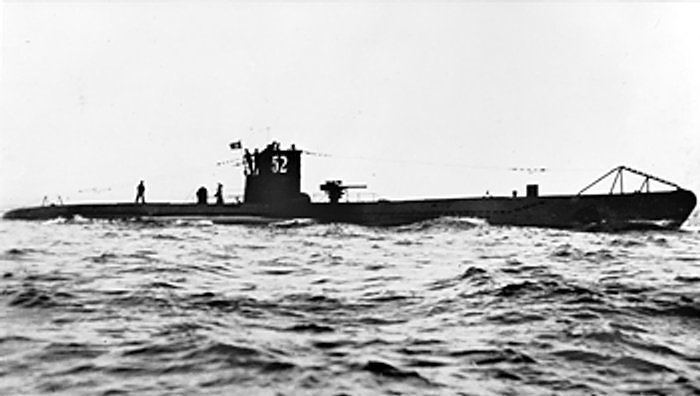Name U-75 Laid down 15 December 1939 Construction started 15 December 1939 Length 67 m Beam 6.2 m | Ordered 2 June 1938 Yard number 3 Commissioned 9 December 1940 Launched 18 October 1940 Draft 4.74 m | |
 | ||
German submarine U-75 was a Type VIIB U-boat of Nazi Germany's Kriegsmarine during World War II. U-75 was moderately successful in her early career in the Battle of the Atlantic, but in autumn 1941 she was dispatched to the Mediterranean Sea with poor results, leading to the eventual destruction of the boat and her crew.
Contents
Design
German Type VIIB submarines were preceded by the shorter Type VIIA submarines. U-75 had a displacement of 753 tonnes (741 long tons) when at the surface and 857 tonnes (843 long tons) while submerged. She had a total length of 66.50 m (218 ft 2 in), a pressure hull length of 48.80 m (160 ft 1 in), a beam of 6.20 m (20 ft 4 in), a height of 9.50 m (31 ft 2 in), and a draught of 4.74 m (15 ft 7 in). The submarine was powered by two MAN M 6 V 40/46 four-stroke, six-cylinder supercharged diesel engines producing a total of 2,800 to 3,200 metric horsepower (2,060 to 2,350 kW; 2,760 to 3,160 shp) for use while surfaced, two BBC GG UB 720/8 double-acting electric motors producing a total of 750 metric horsepower (550 kW; 740 shp) for use while submerged. She had two shafts and two 1.23 m (4 ft) propellers. The boat was capable of operating at depths of up to 230 metres (750 ft).
The submarine had a maximum surface speed of 17.9 knots (33.2 km/h; 20.6 mph) and a maximum submerged speed of 8 knots (15 km/h; 9.2 mph). When submerged, the boat could operate for 90 nautical miles (170 km; 100 mi) at 4 knots (7.4 km/h; 4.6 mph); when surfaced, she could travel 8,700 nautical miles (16,100 km; 10,000 mi) at 10 knots (19 km/h; 12 mph). U-75 was fitted with five 53.3 cm (21 in) torpedo tubes (four fitted at the bow and one at the stern), fourteen torpedoes, one 8.8 cm (3.46 in) SK C/35 naval gun, 220 rounds, and one 2 cm (0.79 in) anti-aircraft gun The boat had a complement of between forty-four and sixty.
Service history
She was laid down on 15 December 1939 at the Bremer Vulkan-Vegesacker Werft (yard), in Bremen as yard number 3, launched on 18 October 1940 and commissioned on 19 December under the command of Kapitänleutnant (Kptlt.) Helmuth Ringelmann.
U-75 carried out training with the 7th U-boat Flotilla in December 1941 until March 1941. She then became operational with the same organization until October. After that, she was reassigned to the 23rd flotilla.
1st patrol
Ringelmann was a good sea officer, who made an impact within three weeks of the boat's initial patrol starting, when on 29 April the submarine torpedoed and sank the 10,000 ton liner City of Nagpur in the Central North Atlantic Ocean, killing fifteen sailors and one passenger.
2nd and 3rd patrols
This success was followed on her second foray with another victim, this time a Dutch freighter, the Elbergen, which went down about 650 nautical miles (1,200 km) north of the Azores. As the Germans watched her demise, the U-boat was illuminated by a searchlight which was hurriedly extinguished by fire from the boat's AA gun.
On her third patrol U-75 sank two British cargo ships - the Harlingen and the Cape Rodney both west of Ireland on 5 August 1941. The latter ship was taken in tow after being hit, but foundered west of Ushant on the 9th. These operations were conducted from the new submarine base at Saint-Nazaire in France, which provided type VII boats like U-75 with a greater patrol range and cruising ability, thus conferring an essential advantage.
4th patrol
The boat's fourth patrol was more unusual, requiring her to slip unnoticed through the heavily defended Strait of Gibraltar and into the Mediterranean to attack allied shipping operating from Gibraltar, Malta and Egypt. She was accompanied in this task by U-79, U-97, U-331, U-371 and U-559, which together formed the 'Goeben' group, (so-named for the German battleship of the same name which had operated in the Mediterranean in 1914). For these operations, U-75's home base was now Salamis in Greece, where she arrived on 2 November. On the journey there, the boat had taken a successful detour along the Libyan coast to see if she could catch any British resupply convoys. On 12 October she had seen just such a convoy and managed to sink two landing craft with gunfire before she escaped.
5th patrol and loss
Her final patrol was from 22 December 1941, and consisted of a similar sweep along the Libyan coast. On 28 December, six days since leaving Salamis, a small coastal convoy was spotted off Mersa Matruh, U-75 launched an attack which sank the small British freighter Volo. The convoy's escorts had spotted the U-boat however, and HMS Kipling ran the submarine down and dropped depth charges on the boat. The explosions forced U-75 to the surface, where 30 of her crew were rescued and taken prisoner by her erstwhile opponent before the boat heeled over and sank, taking 15 men with her, including her only captain.
Wolfpacks
U-75 took part in two wolfpacks, namely,
